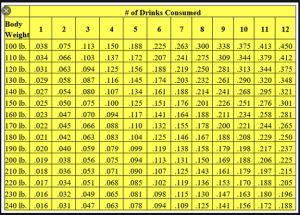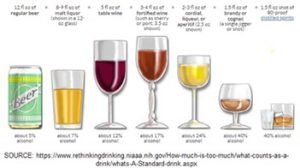Search
Legal Limit for Michigan DUI: .08% BAC Over 21
By Patrick Barone, Michigan DUI Lawyer Near Me

The legal limit in all states except Utah is 0.08 grams percent. It will take about three to four standard drinks to raise most people’s blood alcohol concentration to 0.08 grams %. But, that number of drinks, if consumed rapidly by chugging them, will push the numbers higher.
However, there are many factors that play into a person’s bodily alcohol concentration (BAC) on at a given time and on a given occasion, and the only way to know your BAC at any given time is to submit to the police breath or blood test. Your Michigan criminal lawyer can explain the pros and cons of submitting to one of these chemical tests.
How Many Drinks Does It Take to Reach 08?
Let’s consider what 0.08 really means. First, a 0.08 gr. % legal limit ostensibly relates to the amount of alcohol in a person’s breath or blood. Alcohol tests of a person’s breath or blood are expressed as the percentage of beverage alcohol as a function of mass. Thus, a BAC of 0.08 (0.08%) means that there are 0.08 grams of alcohol for every deciliter (100 ml) of blood or every 210 liters of breath.
Assuming the breath or blood tests used by the police actually measure bodily alcohol levels properly, in considering how many drinks must be consumed to reach a BAC of 0.08%, it is important to agree on the meaning of the word “drink.”
In the United States, the term “standard drink” refers to a drink containing 14 grams (0.6 ounces) of pure ethanol. The following quantities typically have 14 grams of pure ethanol: 12 ounces of 5 percent alcohol-by-volume (ABV) beer, 5 ounces of 12 percent ABV wine, or 1.5 ounces of 40 percent (80 proof) ABV distilled spirits.

When counting drinks, therefore, it is important to know the ABV and the size of the pour. Most craft beers have ABVs higher than 5 percent and are often served in quantities larger than 12 oz. Also, popular craft drinks, such as an Old Fashioned, are often made with “over-proof” bourbon with an ABV of 50 percent or more.
Now that we know the definition of a standard drink, we can turn to the scientific research which has shown that each standard drink has enough alcohol to raise a person’s BAC by approximately 0.017% . The numbers given will vary slightly, depending on the scientific study referenced.
When we consider the complexity of the human body, however, it’s clear that such simple math breaks down. This is a question from Professor Barone’s 2018 law school exam:
- Three men meet for dinner, Mr. Jones, Mr. Smith, and Mr. Howe. Each weigh 160 lbs. Mr. Jones has not eaten all day and is obese. Mr. Smith had a light lunch and works out regularly. This is Mr. Howe’s 2nd dinner, and he works out with Mr. Smith. Each has the same amount of alcohol with dinner at 8:30 p.m. Two hours later who will have the highest BAC?
Few of the law students answered this question correctly, even after sitting through Professor Barone’s lecture and review on the metabolism of alcohol. The question addresses two important variables relative to alcohol metabolism and bodily alcohol content: the type and amount of food in a person’s stomach while drinking and body mass index. Thin people (those with very little fat tissue) metabolize alcohol differently from heavy people with lots of adipose tissue. Plus, those drinking on an empty stomach will cause a higher BAC level, if all other things are being equal.

Taken together these factors help explain why it is perilous to simply count drinks when trying to avoid a drunk driving arrest and conviction. Thus, the only safe way to avoid a drunk driving conviction is to not drink and drive at all! This is ironic when juries sitting on drunk driving cases will be told by the judge:
Just because a person has consumed alcohol or smells of alcohol does not prove, by itself, that the person is under the influence of alcohol. The test is whether, because of drinking alcohol the defendant’s mental or physical condition was significantly affected and the defendant was no longer able to operate a vehicle in a normal manner.
In other words, it’s not unlawful to drink and drive in Michigan, and a jury can’t convict on this basis alone. Unfortunately, this means you are being set up to fail because you can lawfully drink and drive, but if you do, there’s no way to know you won’t be convicted of drunk driving until you take the police test.

Making matters worse, you are not “safe” simply because you have a BAC less than .05 or even 0.08. The reason this is true because in Michigan drunk driving can be proved when a prosecutor can show, beyond a reasonable doubt, that a person’s ability to operate a motor vehicle is materially and substantially lessened due to the consumption of alcohol. This definition of drunk driving in Michigan does not even contain a legal limit.
From this explanation, two things are evident; first, there is no need to reduce the legal limit in Michigan because 0.05 grams % BAC level is already an illegal “number” provided the prosecutor can show that the alcohol significantly impacted the person’s ability to drive their car. Second, lowering the legal limit will cause more people who can still drive perfectly to be convicted of a serious and potentially life-changing crime.
What Is the Legal BAC Limit for a DUI in Michigan?
In Michigan, the legal blood alcohol concentration (BAC) limit for drivers over 21 is 0.08%. If your BAC reaches or exceeds this level while operating a vehicle, you can be charged with operating while intoxicated (OWI). However, Michigan law also allows for DUI charges even below 0.08% if an officer determines that alcohol has impaired your ability to drive.
How Many Drinks Does It Take to Reach 0.08% BAC?
Alcohol affects people differently, so there’s no exact number of drinks that will put someone over the legal limit. Several factors influence BAC, including body weight, metabolism, how quickly alcohol is consumed, and whether food is in the stomach.
As a general guideline, a standard drink is typically:
- 12 ounces of beer (5% alcohol)
- 5 ounces of wine (12% alcohol)
- 1.5 ounces of distilled spirits (40% alcohol)
For many adults, consuming three to four standard drinks in an hour can result in a BAC near 0.08%, but individual tolerance varies.
What Are the Penalties for a First-Time DUI in Michigan?
A first-offense DUI in Michigan can lead to:
- Fines between $100 and $500
- Up to 93 days in jail
- Up to 360 hours of community service
- Possible 30-day license suspension
If the BAC is 0.17% or higher, the penalties increase under Michigan’s “super drunk” law.
Can You Be Arrested for DUI With a BAC Below 0.08%?
Yes. Michigan law allows for an operating while visibly impaired (OWVI) charge if an officer determines that alcohol has affected a driver’s ability, even with a BAC below 0.08%. For commercial drivers, the legal limit is 0.04%, and for drivers under 21, any detectable alcohol can result in legal consequences.
How Can You Avoid a DUI Charge?
The safest choice is to avoid driving after drinking. If you plan to consume alcohol, consider:
- Having a designated driver
- Using a rideshare service
- Taking public transportation
A DUI conviction can impact your driver’s license, employment, and insurance rates.
What Should You Do If You’re Facing DUI Charges?
If you have been charged with a DUI in Michigan, taking immediate legal action is critical. The right defense strategy can help protect your record, license, and future. Contact Barone Defense Firm for experienced legal guidance.
Call (248) 306-9158 and speak to one of our MI DUI attorneys about your BAC the night of your arrest, and how to get your driver’s license back.
 Michigan Criminal Defense Lawyer Blog
Michigan Criminal Defense Lawyer Blog

